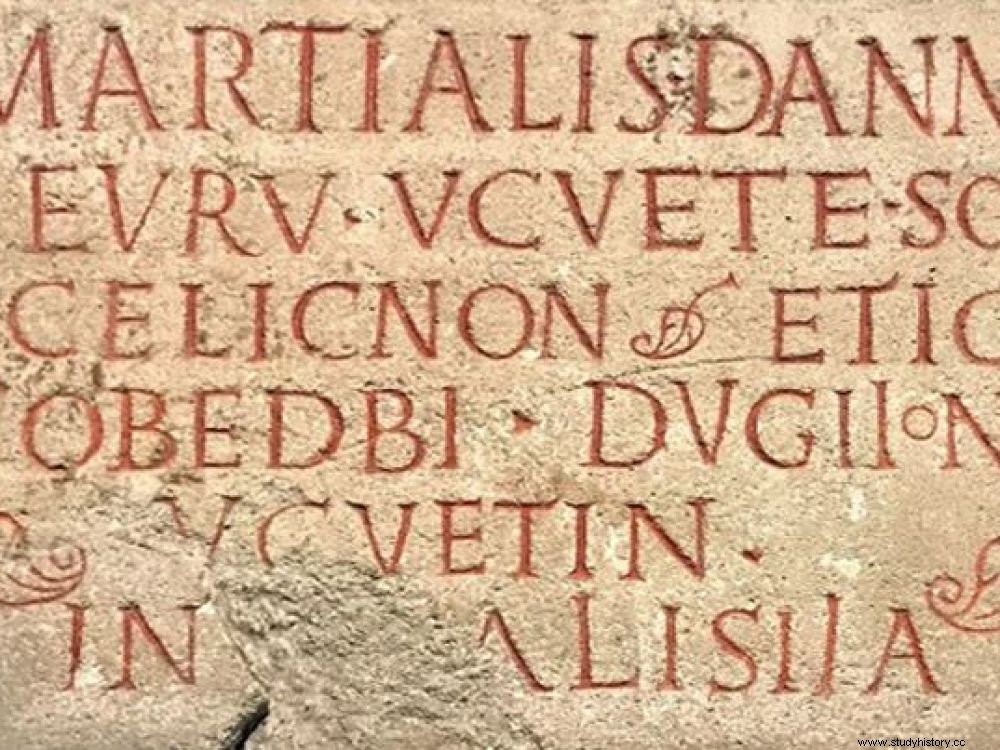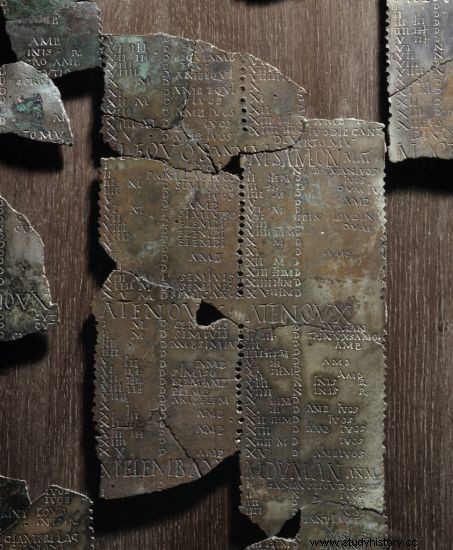A vast program of the National Research Agency provides for the next online publication of all the Gallic inscriptions collected to date.

Gallic inscription of the Cartouche of Martialis (1 st century AD):"martialis dannotali ieuru ucuete sosin celicnon etic gobedbi dugiiontio ucuetin in Alisiia"; or:"Martialis son of Dannotalos offered this celicnon? to Ucuetis and that with the gobedbi (blacksmiths?) who honor Ucuetis in Alise".
"Escengolati aniateios immi" (I belong to Escengolatos and must not be robbed!), or "Segomaros ouilloneos touutious namausatis eiorou belesami sosin nemeton" , (Segomaros son of Villonos, citizen of Nîmes, dedicated this sacred place to Belesama)… Do you know that you have just read two sentences in Gallic language? Two inscriptions over 2000 years old! You could almost hear Asterix salute the famous "Belisama"!
Contrary to what is often imagined, the Gauls left written documents. Short texts engraved on stone, pottery, and sometimes lead sheets. Concerning the ancient world, a received idea is that the Mediterranean basin was then only divided between Greek and Latin. "But the reality is much more complex. There were many dialects by cultural groups" , explains Coline Ruiz Darasse, epigraphist, CNRS researcher at the Ausonius Institute UMR 5607, Bordeaux Montaigne University.
800 inscriptions in Gallic language
At the head of a major project, she coordinates the putting online of a platform where the "computerized collection of Gallic inscriptions" (RIIG), i.e. the publication of all 800 inscriptions in the Gallic language, will be hosted. counted to date, apart from coinage which does not enter into this program. Translated and enriched, these writings will be supplemented by a whole scientific apparatus resulting from data collected by archaeologists, linguists and epigraphists throughout the last thirty years. "On Gaul, we of course have the Commentaries of Caesar, and other historical texts, but thanks to the Gallic inscriptions, we have direct access to the thought of the inhabitants of Gaul between the end of the 3rd century BC. J.C and the 5th century AD." , continues the specialist in languages of fragmentary attestation, the scholarly name of the discipline.

Among the most famous Gallic writings, the so-called Coligny calendar (1st century AD). Archaeological Museum of Lyon. ©Josse/Leemage/AFP
The Gauls wrote by first using the Greek alphabet, which gave Gallo-Greek, then, with Latin letters, Gallo-Latin.
"Escengolati aniateios immi" (I belong to Escengolatos and must not be robbed!), or "Segomaros ouilloneos touutious namausatis eiorou belesami sosin nemeton" , (Segomaros son of Villonos, citizen of Nîmes, dedicated this sacred place to Belesama)… Do you know that you have just read two sentences in Gallic language? Two inscriptions over 2000 years old! You could almost hear Asterix salute the famous "Belisama"!
Contrary to what is often imagined, the Gauls left written documents. Short texts engraved on stone, pottery, and sometimes lead sheets. Concerning the ancient world, a received idea is that the Mediterranean basin was then only divided between Greek and Latin. "But the reality is much more complex. There were many dialects by cultural groups" , explains Coline Ruiz Darasse, epigraphist, CNRS researcher at the Ausonius Institute UMR 5607, Bordeaux Montaigne University.
800 inscriptions in Gallic language
At the head of a major project, she coordinates the putting online of a platform where the "computerized collection of Gallic inscriptions" (RIIG), i.e. the publication of all 800 inscriptions in the Gallic language, will be hosted. counted to date, apart from coinage which does not enter into this program. Translated and enriched, these writings will be supplemented by a whole scientific apparatus resulting from data collected by archaeologists, linguists and epigraphists throughout the last thirty years. "On Gaul, we of course have the Commentaries of Caesar, and other historical texts, but thanks to the Gallic inscriptions, we have direct access to the thought of the inhabitants of Gaul between the end of the 3 e century BC. J.C and the 5 th century AD." , continues the specialist in languages of fragmentary attestation, the scholarly name of the discipline.

Among the most famous Gallic writings, the so-called Coligny calendar (1 st century AD). Archaeological Museum of Lyon. ©Josse/Leemage/AFP
The Gauls wrote by first using the Greek alphabet, which gave Gallo-Greek, then, with Latin letters, Gallo-Latin. "These texts show us how much the Gauls adapted to existing graphic systems" , adds Coline Ruiz Darasse. The study of Gallic epigraphy is a field that arouses the interest of researchers, but also the curiosity of the public. Hence the publication of these ancient quotations placed in their archaeological and historical context for all the curious.
These ancient words also deliver a lot of information. Anthroponymy [study of personal names] with, for example, Segomaros , Martialis or Escengolatos; patronymic filiations like "So and so son of So and so" , in a world where there is no family name, and only that of the father is assigned; toponymy [study of place names], like Namausus for Nimes; or even the names of deities such as Cernunnos the horned god, Belisama, the Gallic Minerva, or Esus .

Cernunnos the horned god of the Gauls (1 st century AD). ©Museo della Civitta Romana
These texts give an idea of the multilingualism and multigraphism with which the Gauls operated
The majority of these transcriptions on stone were discovered in Narbonnaise, in the south-east of Gaul, along the Rhone valley, in Paris, and in the center, Puy-de-Dôme, or Berry. Paradoxically, only one case is known in present-day Brittany. These quotations are most of the time votive dedications, content addressed to deities, or even epitaphs on tombstones. Some have been found in Switzerland, Belgium and Germany. "Rare cases have been encountered in northern Italy where Celtic populations lived. Five Gallic inscriptions are thus transcribed…in Gallo-Etruscan" , says Coline Ruiz Darasse. These texts give an idea of the multilingualism and multigraphism with which the Gauls functioned. "As an example, a stele from the 1 st century BC. J.C found in Velleron, in the Vaucluse, and his dedication:"kaios indoutilo samolatis anektia oualete" ( Caios Indoutilo and his wife Samolatis, daughter of Anektos, hi!). We can see the name of both Gallic and Latin of the owner, the Gallic name of his wife, the final greeting, a Latin word, and the whole inscription is written using the Greek alphabet! With this incised stone alone we have evidence of the intertwining of identities, as much as graphic systems and the language spoken at that time. A true snapshot of the adaptation with which the Gauls operated!" , enthuses the specialist.

Dedication to the Nîmes Mothers preserved in the Museum of Romanity in Nîmes:"[-]artar[os] son of Illanus (it) offered to the Nîmes Mothers, (?) out of gratitude, with the tithe or for the realization of 'a wish". (Translation by Pierre-Yves Lambert). ©RIIG (AND 19-CE27-0003)
Pottery also characterizes other writing materials. These are often very short property titles like "I belong to..." . As in all Antiquity, ribald mentions point from time to time, in particular on drinking objects found in the context of banquets such as jugs decorated with phallus. But not only. Some of these graffiti have been identified on spindle whorls, feminine accessories for spinning wool.

Lead defiction tablet including a text of magic in Gallo-Latin (1 st century AD), found at Chamallières (Puy-de-Dôme), ©Musée Bargoin.
"Another group of Gallic inscriptions on lead sheets are the so-called defixion tablets" , continues the epigraphist. In the ancient world, these malevolent inscriptions were devoted to the infernal deities. Inexpensive and widespread, lead was above all easy to incise. Imprecations, bad spells, magical practices, everything was good to condemn the recipient of the tablet to the public by promising him the worst end. The Gauls used them in the same way as many other peoples of antiquity. "These vengeful tablets were placed in tombs, as it was believed that the dead would more quickly bring curses and anathemas to the infernal deities of the underworld" , says Coline Ruiz Darasse.
About fifteen European researchers are currently collaborating on this program, which should be accessible in its entirety from 2022.
